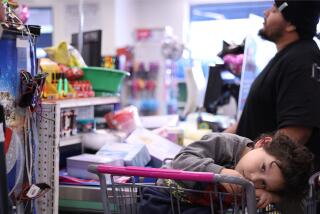Real-life shopaholics in a world of hurt
Ilisa Tanner unlocks the door of a back room in a West Hollywood day spa. A whiff of mothballs wafts out of the small space, which has a folded massage table leaning against one wall and a few “Zen” decorations scattered about. Most of the room, however, is taken up with stuffed clothing racks and piles containing brand-new thousand-dollar “it” bags from Marc Jacobs and Miu Miu, tops from Bebe and Ankh and other trendy contemporary lines, True Religion and Roberto Cavalli jeans, random single items like a matronly St. John dress or a three-piece Dior denim ensemble, and enough Ed Hardy sweat shirts to outfit the cast members of several reality shows.
“This is only part of it,” says Tanner, a self-described “semi-recovering shopaholic” who has also filled two storage spaces and her mother’s garage with the spoils of her shopping addiction. The 46-year-old L.A. native, who wears dark glasses and hides behind a shock of platinum hair, says that she’s racked up debt “in the six figures” and is attempting to pay some of it off by selling her inventory. She’s been renting this room since November and advertising her sale on Craigslist, but business, not surprisingly, is slow. Last week she sold a Gucci bag for $600; this week, nothing so far.
Tanner is among the estimated 5.8% to 8.9% of the U.S. population who display compulsive buying behavior, according to recent surveys done by Stanford University and the University of Richmond, respectively. It’s a hot topic these days, with the entertainment media buzzing about the upcoming release of the movie “Confessions of a Shopaholic,” based on Sophie Kinsella’s novels, and the mental health community actively debating whether compulsive shopping is a social phenomenon or an addiction.
The answer seems to be that it’s most likely both. “I think there are a lot of social elements contributing to this problem,” says Terrence Shulman, a Michigan-based social worker who has written several books about overspending. “But when I start to work individually with people, you can trace back a collection of common issues that really do fuel this problem.” Most addictive behaviors tend to be triggered by depression, anxiety, stress and self-esteem issues; compulsive shoppers, he adds, show many of the hallmarks of addiction: lack of control, attempts to hide and deny the problem, financial consequences and a tendency to relapse.
A touch of affluenza
April Benson, a New York psychologist who specializes in treating compulsive buying disorder, believes that people with addictive personalities will find their poison, whether it’s vodka or Versace. As it happens, our society makes compulsive shopping especially palatable. In fact, Benson reveals, it wasn’t even taken seriously enough to research until the 1980s. “It’s called the smiled-upon addiction,” she says. “Even though it can be as serious as alcohol and drug abuse, it’s one of the only addictions that’s actually condoned.” She adds that we even have cute names for it -- affluenza, aspendicitis, luxury fever.
Tanner unequivocally states that her relationship to shopping is “a sickness. It’s not about needing it or wanting it; it’s a high.” She currently sees an addiction specialist at UCLA who prescribes her antidepressants, yet she does blame some of her urges on her upbringing. “I think living in L.A., especially the Hollywood area, is really based on material things and how you look, how thin you are, how much plastic surgery you’ve had,” she says. “Before high school I was in a private Jewish school, and some people had Louis Vuittons already. I always felt like if I didn’t have a Gucci purse or a Louis Vuitton, I wasn’t accepted.”
With shopping celebrated as a great American pastime -- at least until the bubble burst -- it might have been hard for some people to recognize that there could be a problem brewing. And even now a certain blindness can set in, with discounts on top of already slashed prices at most retailers offering easy rationalizations. “Can you afford not to shop?” Tasha LeMel, a West Hollywood image consultant, asks sarcastically.
Still, the current economic turmoil has had a sobering effect on some compulsive buyers -- “It’s a cold slap in the face,” Shulman says. And those who shop to alleviate stress are getting worse. “They’re feeling like the ship is going down,” he says, adding that he’s only recently gotten around to reading “Confessions of a Shopaholic” and he’s curious to see if the film will reflect the downturn. But even an escapist chick flick, he believes, still has the potential to “stimulate a discussion and paint a portrait of a woman who maybe can’t see her problem from her own vantage point.”
Gowns on a whim
Anika Jackson, 34, identifies herself as a shopaholic, but her definition clearly hews more toward the one put forth by Kinsella’s frothy novels -- all of which she’s read -- than the disorders discussed by Shulman. Growing up in Kansas, she used to buy ball gowns for no reason and as a young raver, she owned “50 miniskirts with matching accessories.” Today, Jackson is the mother of a 9-month-old daughter whose closet is filled with clothes that will keep her well-dressed until she’s 3 -- too cute to pass up.
The Manhattan Beach resident has a husband willing to indulge her. Before the couple married, she charged $25,000 on her then-fiance’s credit card, which he learned about one day on the golf course when he received a call about his delinquent bill. Now Jackson works hard to “monitor” herself. “I try to only spend money that I have on hand or use one credit card.” She’s never, incidentally, frozen her cards in ice like the “Shopaholic” protagonist does, but she has cut one up -- and then immediately called to ask for a replacement.
These days, Jackson’s most effective way of avoiding spending is simply to stay out of stores, “because if I walk in somewhere, I will find something that I like.” She cannot enter Anthropologie without spending “$800 to $1,000.” Jackson does almost all of her shopping online, at websites that offer discounts. We’re not talking about Overstock.com, though. Some of the labels she’s recently picked up with a click? Dolce & Gabbana, Prada, Christian Lacroix, Michael Kors, Alessandro dell’Acqua, Sonia Rykiel, Cole Haan and many more.
Marika Krissman Tsircou, 36, of Los Feliz, a friend of Jackson’s and a fellow shopaholic, says that she receives so many packages from her online purchases, her UPS man knows her dogs by name. “Someone has to keep the economy going, right?” she jokes.
But somewhere between the bailouts, the sad cautionary tales like Tanner’s, and Jackson’s growing sense that she possesses “way too much stuff,” a new awareness seems to be setting in.
“Conspicuous consumption has taken on a new light,” Shulman says. “Greed is no longer good. We’re all reexamining how we approach money, credit cards, debt, materialism. I think everybody’s involved in this conversation, which is good.”
Benson, whose second book, “To Buy or Not to Buy: Why We Overshop and How to Stop,” was published in December, offers these practical words: “People have to figure out what it is they’re really shopping for, and how to get that.” If you’re shopping out of loneliness or boredom, she suggests finding other ways to meet those needs, wisely noting, “You can never get enough of what you don’t really need. It’s like looking for love in all the wrong places.”
More to Read
Sign up for our L.A. Times Plants newsletter
At the start of each month, get a roundup of upcoming plant-related activities and events in Southern California, along with links to tips and articles you may have missed.
You may occasionally receive promotional content from the Los Angeles Times.






